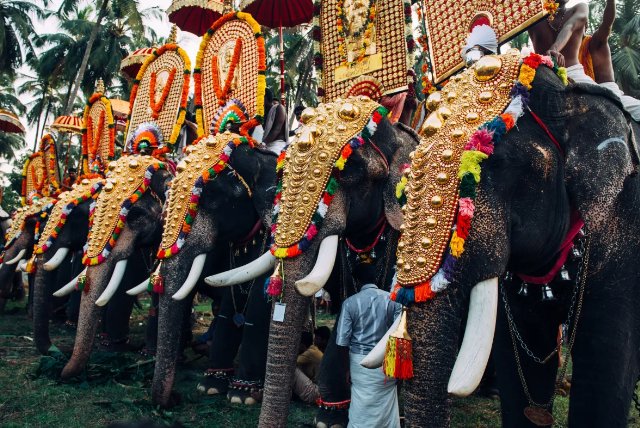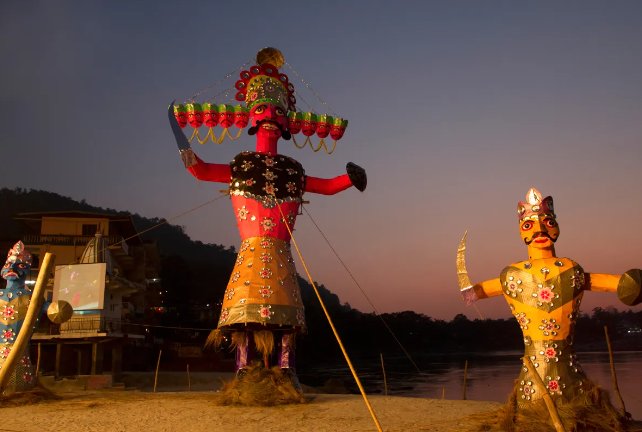FESTIVALS
From North to South: Dusshera celebrations across India
By BIGBASKET, 17 Oct 2023
The mailer sent out by Bigbasket during the Navaratri celebrations has been reproduced here. The screen shot of the entire article with images has also been featured
Dussehra, also known as ‘Dassara’, ‘Vijayadashami’ or ‘Dasaain’ etc.
is one of the most prominent festivals of India. It is a festival
celebrated for the triumph of truth over evil. The mythology behind this
festival is that Lord Rama, an avatar of Lord Vishnu, beheaded the 10th
head of the 10-headed evil king Ravana. Ravana had abducted Lord Rama’s
wife Sita, for which Lord Rama sought revenge. This day marks the
victory of Lord Ram’s confrontation with evil King Ravana and thus is
known as the victory of good over evil. This day is also celebrated as
the day Mahishasur was destroyed by Goddess Durga.
There is a varied significance of this festival, it is, of course, the
celebration of the demolition of the evil king Ravana, it also commences
Lord Rama’s journey back to Ayodhya, which invariably means the
celebration of Diwali.
Dussehra is also in sync with the 10th day of Navratri festivities and
the festivities of Durga Puja. And so the day has great importance in
most parts of India.
The typical celebration of Dussehra commences with a sort of theatrical
enactment of the scene as described in the Ramayana where a huge effigy
of king Ravana is created and is filled with firecrackers and other
combustible items. This effigy is created as close to the mythology,
adorned with 10 heads for King Ravana. Then a person is elected to play
the role of Lord Rama, he is often even dressed as Lord Rama, who uses a
bow and arrow, often lit with fire. This arrow is aimed at the head of
King Ravana. Once the fired arrow hits the head of the effigy, it sets
on fire with great dramatics due to the firecrackers stuffed in it. This
is then celebrated with great fervour.
This sort of celebration is very commonly seen in the Northern part of
India. However, India is a land of ‘Unity in Diversity’, so the
celebrations vary in many states. Many different states celebrate
Dussehra in a variety of ways.
Durga Puja in West Bengal
West Bengal and its neighbouring states celebrate Dussehra as the final
day of Durga Puja. Huge pandals are created with Idols of Goddess Durga,
and people throng such pandals to get a glimpse of idols of Goddess
Durga.
Food Eaten during Durga Puja: A typical Poojo thali that is eagerly
consumed on Durga Puja comprises luchi, Aloor Dom, Chop Cutlet, Mishti
doi, shukto, dal, bhaat, begun bhaja, maach, maangsho, etc.
Navratri in Gujarat
Gujrat celebrates Dusshera as the final day of Navratri. It is
celebrated in a very colourful and musical way. People dress up in
traditional attire like Gharghra Choli for women and Kedia for men. They
perform a traditional dance known as ‘Ras Garba’ and ‘Dandiya ras’
which are the highlight of the festivities.
Food Is Eaten during Navratri: Navratri in Gujrat and many parts of
India are celebrated with fasts. So the food includes sabudana khichdi,
potato wafers, farali wada etc. Dusshera is then celebrated with sweet
preparations like dudh paak, puri, pulav, kadhi.
Carnival Festival of Karnataka

The state of Karnataka celebrates Dussehra with full grandeur and
opulence. A captivating parade-like carnival is organized in the
Madikeri area of Coorg. It is a vibrant and colourful festival that is
dedicated to Draupadi. It includes folk dances, cultural performances,
elephant chariots and much more.
Food Eaten in the Carnival: Dussehra is also celebrated as the
commencement of the rice harvest and so consuming ‘hosth anna’ or ‘new
rice’ is an integral part of the celebration. Coconut rice is prepared
along with other accompaniments like rasam, vadai, sambhar, papadum,
payasam etc.
Ram Leela of Delhi

Being a part of Northern India, Delhi and many other parts of the
country, celebrate Dussehra by creating pandals where a 10-day-long
enactment of the highlights of the Ramayana is carried out. This 10-day
long set of enactments is known as ‘Ram Leela’. Local theatre artists or
drama enthusiasts participate in this enactment. This often is a
highlight in every locality, community grounds etc. Commonly, the Ram
Leela is carried out at night, and so most locals from nearby
households, come to watch the skit post their daily chores. The final
day of Dussehra celebrations includes the burning of the effigy of
Ravana as mentioned earlier.
Food eaten during Dussehra Celebrations: Commonly the period of Navratri
is celebrated by observing fasts for 9 days including consumption of
fruits, milk etc. Dussehra celebrations include eating besan laddoo,
jalebi as well and rice kheer.
Kulasekarapattinam Dasara of Tamil Nadu
Other celebrations for Dussehra in Tamil Nadu include worshipping
Goddesses like Durga, Sarawathi, Laxmi etc. They also have doll shows
which are a very popular part of the Dussehra celebrations.
Food Eaten for Dussehra in Tamil Nadu: Preparation of Pongal, sago
payasam, sundal and other such sweets is an integral part of the
celebrations.
Other forms in which the festival is celebrated in different parts of
the country are, ‘Ravana Dehan in Uttar Pradesh, the Procession of Lord
Raghunath in Kullu, Himachal Pradesh, Fasts and Shakti worship done in
Punjab, Nature Worshipping done in Chhattisgarh etc.
Significance of Dussehra in Life
Dussehra is a day that is more than just celebrations and cooking
delicious meals at home. This day teaches us some important life lessons
as well.
Dussehra teaches that truth is always victorious over evil, just as it
did in the case of Lord Rama as well as Goddess Durga. It tells us
always to stand by what is true and fight for it. The evil may seem more
attractive and may seem easier but it is not the correct path one must
take.
It also teaches us a simple lesson, that though things may seem tough, there is always light at the end of the tunnel.
 |